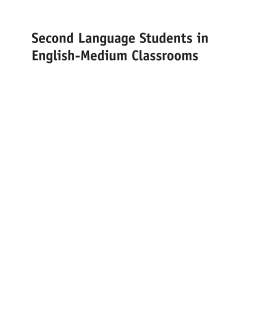
Additional Information
Book Details
Abstract
Second Language Students in English-Medium Classrooms offers a real-life practical guide to teachers that will enable them to serve students from many linguistic and cultural backgrounds effectively. Written in an accessible manner it includes numerous exemplary strategies and resources as well as practical references to the latest uses of embedded technology. All of these are designed to reflect contemporary practice in international schools. The book also tackles the controversial and politically-charged issues of the potentially overwhelming impact of English in global contexts and the use of students’ mother-tongues in English-medium classrooms. Written by an author and researcher with over 35 years’ experience, this book is an essential resource for all teachers, administrators and parents of children in international schools.
A comprehensive handbook for teachers in today’s international schools. Coreen Sears provides a necessary emphasis on emergent bilinguals as she walks the reader from the absolute basics to the more complex elements of providing for globally mobile students. Pertinent points are raised and carefully illustrated through clear, real life examples, references and links. This is a must-read for anyone working in an international school setting!
Coreen Sears has worked within the world of international education as teacher, researcher and consultant for over 35 years. Her focus throughout this time has been on ways to offer effective academic and social experiences to linguistically and culturally diverse students. Her bestselling book Second Language Students in Mainstream Classrooms has supported thousands of teachers in international schools worldwide since its publication in 1998.
Drawing on real international classrooms and latest academic research, Sears offers practical pedagogical strategies for optimising second-language learning which are contextualised within the broad spectrums of communities (learners, teachers and parents), curricula, and teaching environments found in international schools worldwide. This is an invaluable comprehensive resource for 21st century international school educators.
Understanding bilingualism and the theories of language learning and acquisition is key to teacher effectiveness in international schools, and this book outlines them in accessible detail. In so doing, and perhaps most importantly for the propagation of the educationally sound evidence-based views put forward in this book, it empowers practitioners to advocate for best practice within their schools...This book offers a one-stop opportunity for busy leaders, administrators and practitioners to validate held beliefs and develop their professional knowledge. The book is a 'must-read' for teachers new to the international circuit, and experienced teachers who want to become more effective in the multicultural classroom. It is for anyone planning a teacher in-service training programme or presenting information to parents or looking for a comprehensive set of practical suggestions for starting the year with emergent bilinguals.
Jane Fox, ACS Egham International School, UK
One of my first positions when I was still studying at university was as a substitute teacher at one of the international schools in Italy. This book perfectly presents, and aids the reader in understanding, the atmosphere in an international school deriving from the advantages of a multilingual setting. I found many of my own impressions from that time in the present book.
Francesca Costa, Università Cattolica del Sacro Cuore di Milano, Italy
Table of Contents
| Section Title | Page | Action | Price |
|---|---|---|---|
| Contents | v | ||
| Figures and Tables | xi | ||
| Text Boxes | xiii | ||
| Acknowledgements | xv | ||
| Introduction | xvii | ||
| Part 1 The World of International Education | 1 | ||
| 1 Introducing International Schools | 3 | ||
| 2 Being Mobile: Parents, Students, Teachers | 22 | ||
| 3 Adjusting to a Life of Change | 41 | ||
| Part 2 Programmes and Policies in International Schools | 63 | ||
| 4 Introducing Programmes of Study to be Found in International Schools | 65 | ||
| Part 3 Bilingualism and Language Learning | 89 | ||
| 5 Bilingualism in the International School Context | 91 | ||
| 6 Being Informed About Language Learning | 117 | ||
| Part 4 Day-to-Day Life in Mainstream Classrooms Containing Emergent Bilingual Students | 139 | ||
| 7 Using School-wide Approaches and Resources to Promote the Learning of Emergent Bilingual Students | 141 | ||
| 8 Explaining the Learning Culture of the School to Students and Parents | 166 | ||
| 9 Enabling Emergent Bilingual Students to Access the Language of the Classroom | 183 | ||
| Part 5 Working With Emergent Bilingual Students in the Mainstream Academic Programme | 201 | ||
| 10 Key Strategies for Use With Emergent Bilingual Students in the Content Areas of the Curriculum | 203 | ||
| 11 Planning for the Language and Content-area Learning of Emergent Bilingual Students | 222 | ||
| 12 Teaching the Skills of Class Talk and Literacy to Emergent Bilingual Students | 251 | ||
| 13 Scaffolding the Learning of Emergent Bilingual Students in the Mainstream Classroom: Class Talk, Mathematics, Science and Social Studies | 273 | ||
| Epilogue: Final Thoughts | 295 | ||
| Appendix A | 297 | ||
| Appendix B | 298 | ||
| Bibliography | 299 | ||
| Index | 303 |
